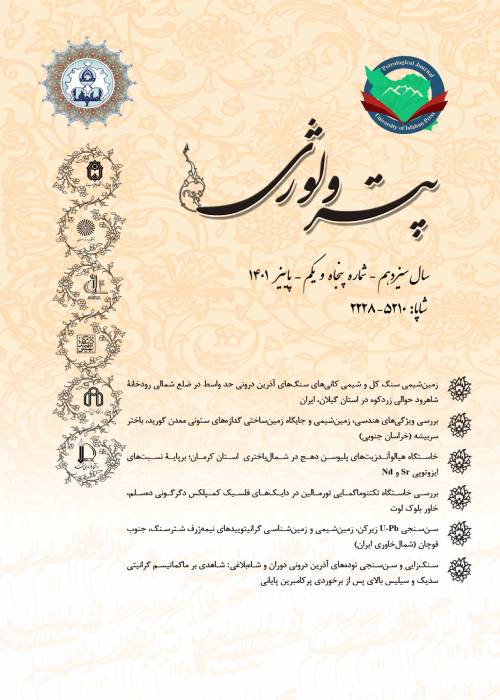Petrogenesis and dating of Doran and Shah Bolaghi intrusions: Implications for post-collisional sodic and high-silica granitic magmatism
The Precambrian-Early Cambrian magmatism in Iran includes magmatic rocks in the central, northwestern (e.g. Tekab-Zanjan zone), and northeastern parts of the Iranian plate. Although in the previous literature, the petrogenesis and tectonic setting of these rocks were attributed to the rifting and extensional tectonic regime but recent studies emphasized that they formed in a convergent subduction-related tectonic setting. In this study geology, geochemistry, petrogenesis, and dating of Doran and Shah Bolaghi (Moghanlu) intrusions as the best examples of the Precambrian-Early Cambrian magmatism in the NW Iran have been investigated.
Geology:
In NW Iran, there are intrusive and related volcanic rocks that have been outcropped in a special stratigraphic position. The intrusive rocks cut the Precambrian Kahar Formation rocks and are overlaid by the Bayandor Formation rocks. Stratigraphically, the equivalent volcanic rocks (Gara Dash rhyolitic series rocks) lie between over Kahar and lower Soltanieh Formation rocks. In the area, Doran–type intrusions including Doran, Moghanlu, Incheh, Sarveh Jahan, Mahneshan, Aghkand, and Alam Kandi, have been intruded as batholith (e.g. Shah Bolaghi) and as stocks (e.g. Doran and Sarveh Jahan) and mainly they affected by dynamo thermal metamorphism. The studied Doran and Moghanlu intrusions included different felsic pulses of the oldest mica granite, hololeucocratic porphyritic granite, and the youngest potassium feldspar-bearing pink granite associated with basic rocks.
Petrography:
The studied plutons including different pulses display various mineralogy. The Hololeucocratic mica granites show granular to porphyry textures including quartz, alkali feldspar, and plagioclase associated with biotite and rare muscovite. Some albite crystals are magmatic and chessboard albites formed during Na-metasomatism. Hololeucocratic porphyry granite show various porphyry and granular as well as cataclastic textures. Secondary chessboard and myrmekitic albite developed along with primary albite and antiperthite feldspars. Rare primary muscovite can be found. Pink granite includes quartz and alkali feldspar and plagioclase minerals with porphyry to granular textures and some hypersolvus potassium feldspar megacrysts developed. Rare muscovite and biotite crystals have been developed. In all granitic rocks, recrystallization and secondary minerals have been developed due to metamorphism, tectonic and metasomatism processes.
Geochemistry:
All granitic rocks show high silica content (79-82 wt.%) and in the R1-R2 diagram located in alkali granite to syenogranite fields and metaluminous to weak peraluminous. Basic rocks have 49-50 wt% SiO2 content and are olivine gabbro. The TiO2, Fe2O3, MgO, CaO, and P2O5 contents of studied granitic rocks are very low and porphyry granite and mica granites show very low K2O and high Na2O contents but mica granites show K2O/Na2O~1. In the spider diagrams, the porphyry granite samples show enrichment in the Zr, Th, Nb, Ta, U, and HREE (heavy rare earth elements) and trough in the LREE (light rare earth elements), and large ion lithophile elements (LILE: Cs, Rb, Ba, K), P, Ti, E, however, the mica granites are characterized by LILE (Cs, Rb, Ba), Sr, K, P, Ti, Eu, HREE, LREE, Zr, Th, and U enrichment, and the pink granites show a diverse pattern with enrichment in LILE and LREE and depletion in Sr, P, Nb, Ta, and Ti. All granitic samples show very clear troughs in Eu and Eu/Eu*.
U-Pb Dating:
Zircon crystals from Doran porphyry granite and the Shah Bolaghi pink granite have been dated by the U-Pb method. The porphyry granite apparent 206Pb/238U ages range from 515 to 1192 Ma. In the relative frequency histogram, the porphyry granite ages show two peaks in 550 and 1050 Ma, which older ages can be related to inherited crystals and or captured crystals during ascending of the magma. Pink granite apparent 206Pb/238U ages range from 478 to 657 Ma. The porphyry granite zircon crystals' younger ages yield a weight mean of 565 ± 28 Ma, 95% conf. n=14, MSWD=0.54 and the pink granite ages yield a weight mean 538 ± 12 Ma, 95% conf. n=23, MSWD=1.02. Dating results are compatible with field observation that the pink granite cut porphyry granite.
The studied granitic intrusions are inhomogeneous and different mica granite, granite porphyry, and pink granite associated with basic rocks could be distinguished. The investigated granitic rocks are marked by A/CNK<1.1 and Zr+Nb+Ce+Y <300 as well as 104*Ga/Al<2.6 that are different from S- and A-type granites and very high silica content and lower La, Y, Nb, Zr, Ga, Zn, Ce contents which led us to be considered as fractionated I-type granites. Different petrogenetic models have been proposed for fractionated I-type granites generation, including:(1) Partial melting of the crust which the melt composition may have been modified by fractional crystallization;(2) fractional crystallization of hornblende and clinopyroxene from initial intermediate to mafic melts;(3) involvement of a fluid residual or hydrothermal phase during late magmatic stages.
- حق عضویت دریافتی صرف حمایت از نشریات عضو و نگهداری، تکمیل و توسعه مگیران میشود.
- پرداخت حق اشتراک و دانلود مقالات اجازه بازنشر آن در سایر رسانههای چاپی و دیجیتال را به کاربر نمیدهد.


